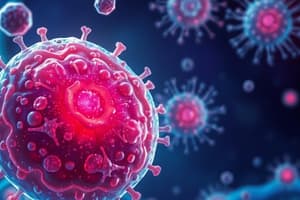Podcast
Questions and Answers
Name the two groups of cells.
Name the two groups of cells.
Prokaryotic and Eukaryotic
What is an example of a prokaryote?
What is an example of a prokaryote?
Bacteria
What does the nucleus control in a cell?
What does the nucleus control in a cell?
Controls cell activity — contains genetic material
What are the functions of ribosomes?
What are the functions of ribosomes?
What structure in plant cells contains chlorophyll for photosynthesis?
What structure in plant cells contains chlorophyll for photosynthesis?
What is a specialised cell?
What is a specialised cell?
What is the function of mitochondria?
What is the function of mitochondria?
Which structure in plant cells helps to keep the cell rigid?
Which structure in plant cells helps to keep the cell rigid?
What differentiates chloroplast from chlorophyll?
What differentiates chloroplast from chlorophyll?
What adaptation allows sperm cells to swim towards the egg?
What adaptation allows sperm cells to swim towards the egg?
Flashcards are hidden until you start studying
Study Notes
Cell Biology - Cell Structure
- Two groups of cells: Prokaryotic and eukaryotic
- Prokaryotic cells:
- Smaller in size
- Lack a nucleus
- Genetic material found in a single DNA loop
- May contain plasmids (small circular DNA)
- Examples: bacteria
- Eukaryotic cells:
- More complex
- Have a nucleus
- Genetic material stored within the nucleus
- Examples: animal, plant, fungi, and protista
- Organelles and their functions in animal and plant cells:
- Ribosomes: protein synthesis
- Mitochondria: aerobic respiration (energy release)
- Nucleus: controls cell activity, contains genetic material
- Cell membrane: controls movement of substances in and out of the cell
- Cytoplasm: liquid gel where most cell reactions happen (like anaerobic respiration)
- Plant cells have additional organelles:
- Cell wall: provides strength, made of cellulose (also found in algae)
- Chloroplasts: contain chlorophyll for photosynthesis
- Vacuole: stores cell sap, helps maintain cell rigidity
- Chloroplasts vs chlorophyll: Chloroplasts are organelles that contain chlorophyll, which is the green pigment that absorbs sunlight for photosynthesis.
- Cell differentiation: As an organism develops, cells specialize for particular functions.
- Specialized cells: cells with specific structures adapted for their functions.
- Examples of specialized animal cells:
- Nerve cells: long axons for transmitting electrical impulses, specialized ends for releasing chemicals, abundant mitochondria for energy.
- Muscle cells: many mitochondria for rapid respiration, stores glycogen for energy.
- Sperm cells: tail for swimming, mitochondria for energy, acrosome (head) containing enzymes for fertilization.
Studying That Suits You
Use AI to generate personalized quizzes and flashcards to suit your learning preferences.




